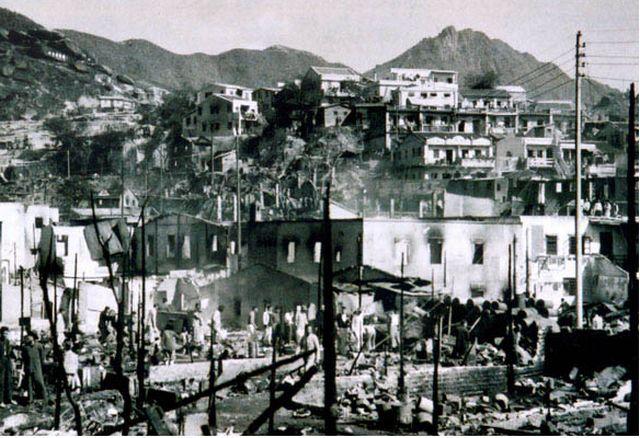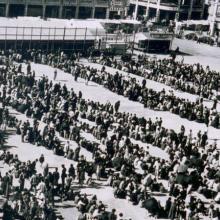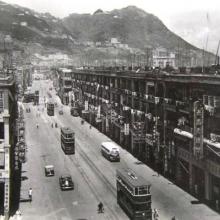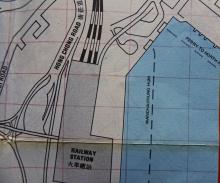Photo courtesy of reader Moddsey.
Get Gwulo's books
Directory
Click on your area of interest to choose from over 30,000 pages about old Hong Kong:
- Images & photos
- View - View galleries - View new - Create - Forum topics
- View - Create - Places & buildings
- View map - View new - Create - Streets
- View map - View new - Create - People
- View - View new - Create - Organisations
- View all - View new - Create - Diaries & memoirs
- View - View new - Create diary - Create page - Events
- View - View new - Create - Jurors lists
- View - Type a page
Or choose a popular article:





Comments
Shek Kip Mei Fire 1953
Can anyone outline the area that was destroyed by the 1953 fire corresponding to the current city streets?
The hill northeast of Boundary St and Tai Po Road was bigger in those days until residential development in later years. I hiked up that hill in 1956 from Tai Po Road and walked by shanty huts part way up the hill so they were not affected by the 1953 fire, or their owners built there after the fire. There was a very small stream running by their homes making the place a bit romantic. I am curious when these folks moved out.
On the southside that faces the soccer stadiums on Boundary St, there were big cuts onto the hillside intended to stablize the hill and huge dragon flies hoovering above them to catch insects, and men went there to watch the games below.
There was a fire that destroyed the shanty town on the northwest quadrant of Boundary St and the railway, not sure if it was the same 1953 fire.. After the fire, I could see the ruins from Boundary St. This area would remain undeveloped for sometime after the fire. I caught some fairly large grasshoppers there (need to run fast after them when they fly) to feed my birds. Current Google photos show some tennis courts there.
In 1956, I visited my relatives in Shek Kip Mei Village, not sure if their place was rebuilt (still shanty looking) after the fire or unaffected by the fire. It was an interesting time and place albeit short - someone's big pig wandering around the neighbourhood lanes (more messy when it rained), and a huge boulder resting precariously on the hill above their neighbourhood.
re: Shek Kip Mei Fire 1953
I haven't seen any map that shows the area affected by the fire. If anyone knows of one, we could overlay it on a modern map of that district.
Regards, David
PS Michael Rogge has a video showing some of the area that was affected:
Shek Kip Mei Fire 1953
Thanks David for the link to Rogge's video among his several also excellent videos.
Following the fire, some of these folks moved to the roof top above my grandparent's (rented) flat by Boundary St and Ki Lung St . The young men, singles from mainland, made shoes for Kowloon Shoes retail across the street. There were also dwellers of other ages from babies to seniors, and some having belongings not much more than a sleeping mat and night table. The room partitions were simple and crude (no offence intended). This young boy often visited them and played table tennis up there.
In the 1950s there were several floods in our neighbourhood. Following a heavy rainfall, Boundary Street would become a wide stream with 10 inches deep muddy water flowing westward to the sea. For us children it was exciting time. Some shop owners constructed a concrete barrier across the front of the shop to protect them from flood. I noted these barriers (for example, the one below our flat) were removed by about 1960.
Shek Kip Mei Fire 1953
Though in Chinese, further information from the HKPL here
Shek Kip Mei Fire 1953
Thanks Moddsey, I will be listening and viewing your referred links with earnest. My HKID file was issued in about 1958 (year not legible) so it is vintage.
如意坊 三巷 一號 二樓, was in the Shek Kip Mei (shanty) Village.
Re: HKID Card
Yes, vintage. First generation HKID Card.
Re: 1953 Shek Kip Mei Fire
There are a few Harrison Forman photos dated post 1953 showing the Shek Kip Mei squatter area, hillside, residents and completed estate blocks as seen here
1953 Shek Kip Mei Fire
https://collections.lib.uwm.edu/digital/collection/agsphoto/id/23415/rec/18 - the gutter - I hopped from one side to the other to start hiking uphill. The water quality was better higher up. "Sand" worms, for feeding tropical pet fish, could be seen in spots along the way. Comic books were popular for children in the 50s and 60s. For 5 cents the man would give you one or two stamped tickets the size of a thumb, which you turn in to borrow his books. They had good collections of Kung-fu and romance and added few new ones every week. Knowing I was reading Romance of the Three Kingdoms, my aunt in Guangzhou (Canton) got me one from that series. The drawings are attractive and narrative easy to understand.
Shek Kip Mei Fire 1953
Moddsey, I refer to Photo #12 of the 18 photos by Harrison Forman in your link. In it, we see about 20 children and 3 adults in the foreground. Mr. Forman was standing somewhere outside my relative's Shek Kip Mei address 如意坊 三巷 一號 while aiming his camera to the end of the lane. I often visited them and slept over in 1955-56 as a young adventurous boy does. I am convinced about this photo's location and that the area escaped the 1953 Fire: the gutter running outside their home, the outside finishing of their wooden building, the closed windows at the house across, the new addition at the end of the lane, and general appearance of the living quarters in the background.
Images of the fire
Hi, More or less by chance I found a couple of images on Flickr starting here. Possibly these can help to see more of the extent of the fire.
Regards, Klaus
Location mix up?
Hi Klaus,
Whoever posted the photos you link to seem to have confused the locations where they were taken. While I can understand HSBC was probably in Hong Kong, the other photos with general damage just don't look like Hong Kong. In my mind, Shek Kip Mei was a squatter fire, so having so many brick buildings damaged just doesn't look like it. Perhaps it looks like bomb damage. Anyhow, some photos have Korean words on them and many others seem to have people wearing traditional Korean clothes/footwear.
Unsure which one can be pinpointed as the Shek Kip Mei fire, if at all.
breskvar
Korea
agree with Breskvar, those pictures of the ruins look like Korean war photos. There are a few of HK scattered in amongst them though.